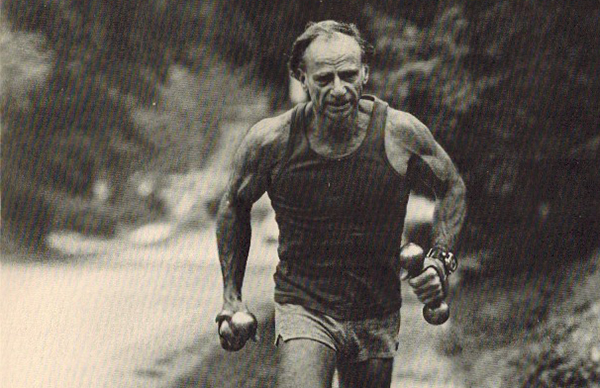
When the physician and psychiatrist Leonard Schwartz surveyed his life at middle-age, he was not particularly happy with the state of himself as a physical specimen. Decades of smoking, overwork, and living a sedentary lifestyle had left him with high blood pressure, chronic back pain, and a generally subpar level of energy.
Dr. Schwartz began incorporating swimming and running into his routine, and found these exercises brought him to a decent level of fitness. But he still felt he wasn’t where he wanted to be health-wise.
It was at this point that the good doc developed a fitness system that ultimately lowered his heart rate, cut his running times in half (despite doing less mileage), upped his strength, dropped his weight, and exponentially boosted his vim and vigor.
The name of his system was “Heavyhands” and with the publication of Heavyhands: The Ultimate Exercise and Heavyhands Walking in the 1980s, Schwartz’s methodology became something of a national sensation. Though the workout has now largely been forgotten, it’s deserving of a resurrection.
The Origins of Heavyhands Walking

The idea for Heavyhands grew out of Schwartz’s discovery that the athletes with the highest VO2 max (generally considered the best indicator of cardiovascular fitness) were not cyclists, nor runners, but cross-country skiers.
From this insight, Schwartz drew a conclusion that was both intuitive and seemingly neglected: when it came to achieving cardiovascular fitness, “Four limbs are better than two.”
Most forms of cardio, the doctor observed, greatly emphasized the lower body over the upper. Activating the latter as much as the former, Schwartz hypothesized, could thus significantly increase the workload, and the subsequent health benefits, of exercise.
Schwartz began to test his theory both on himself and in a laboratory by taking small dumbbells in each hand and then performing all sorts of exercises: striding and swinging the dumbbells using the “double pole” maneuver cross-country skiers employ; running (for distance and in place); lunging, jumping, and dancing; and just generally moving his legs and swinging dumbbell-laden arms in all kinds of directions and combinations.
While all these varied calisthenics proved effective, Schwartz found that doing the “Heavyhands Walk” — essentially walking while pumping dumbbells with one’s arms — was the “best way to begin combined, four-limbed movements” and the most natural form of heavy-handed exercise.
The Benefits of Heavyhands Walking
Walking is an oft-recommended exercise, and while it’s certainly better than doing nothing, it’s a pretty light form of activity, with lightweight benefits to match. A Heavyhands Walk transforms a pedestrian saunter into what Dr. Schwartz believed is “an exercise that makes one more mechanically strong and aerobically powerful than any other combination of exercises could.” Schwartz called it “Walk Plus” — an activity that couples all the normal benefits of walking (gets you outside, doesn’t involve real skill, can be done anywhere) with these additional advantages as well:
Whole body exercise. Even in our day-to-day life, outside of a dedicated workout, our legs get “exercise” by default by having to carry us from one place to another. Our arms, in contrast, typically just kind of hang there. Even when we do engage in intentional cardio, our lower bodies often do a greatly disproportionate amount of the work; the arms and torso are fairly inert in cycling, for example, and even when running, one’s arms swing through the air without resistance. That leaves a lot of the body on the passive table; as Schwartz observed, “While arms are small compared to legs, the upper body contains fully 65 percent of our total muscle mass!” Heavyhands engages all the muscle groups of the body, bottom to top.
Strength + cardio. While Heavyhands is primarily a cardiovascular exercise, it does build a bit of strength too. While doing thousands of repetitions with light weights isn’t going to make you big and
No comments:
Post a Comment